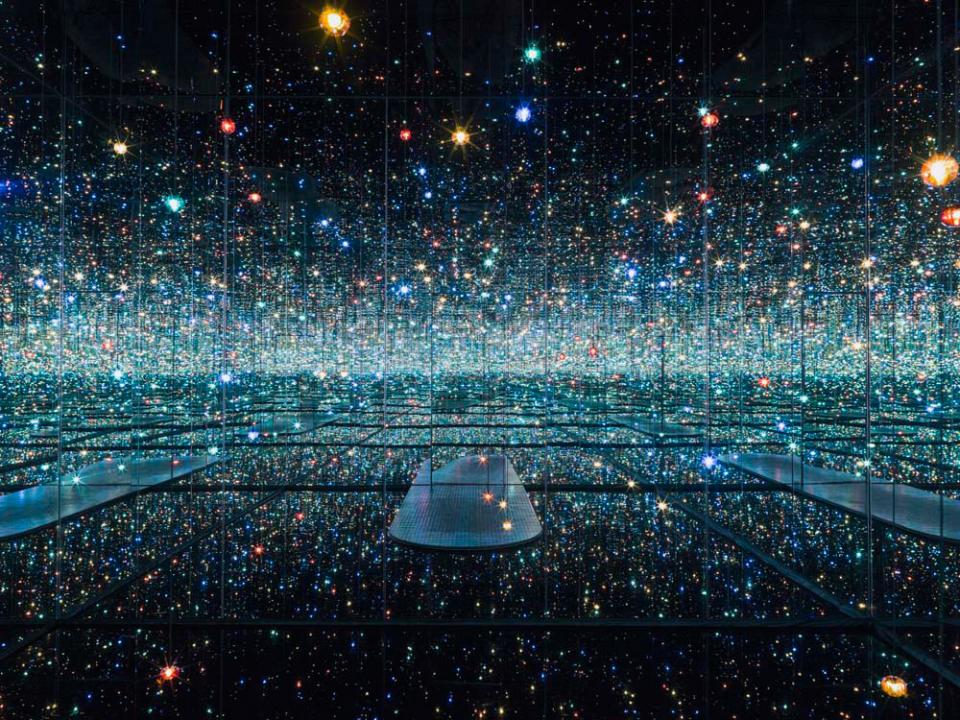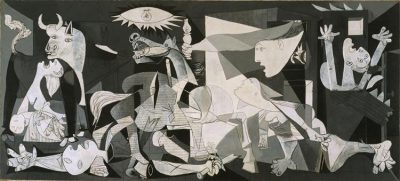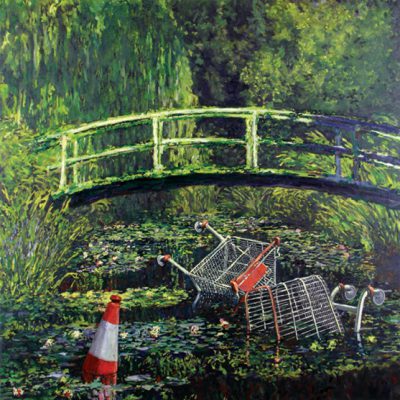The Recent Past 1914–Present
The Broad Art Foundation Spotlight Object
Infinity Room

Infinity Mirrored Room—The Souls of Millions of Light Years Away
Yayoi Kusama
2013
Wood, metal, mirrors, plastic, acrylic, rubber, LED lighting system
Room installation
The famous Japanese artist Yayoi Kusama, known for her eccentric artworks and installations, created “infinity rooms:” an interactive and immersive experience into Kusama’s world of fantasies. Audience participation is integral to this work, as each viewer walks away with a personalized experience. Infinity Mirrored Room—The Souls of Millions of Light Years Away (2013) is a mirrored and LED-lighted room that seems boundless; flickering, rhythmic lights mimic the galaxy and the stars, fostering an out-of-body experience. Kusama began exploring the concept of mirrored infinity rooms in the early 2000s, gradually developing themes revolving around life, existence, and perception.
Artemis Tzioli
Art History Program, VCUarts Qatar
The Big Picture
The past 100 years of history have been marked by a dramatic upheaval in global affairs, state formation, and sovereignty, as well as a change in social thought, marked by the desire to move away from the classical views of the Renaissance. After the collapse of the Ottoman Empire in 1922 and the decline of the British Empire in the first half of the twentieth century, a wave of independence movements granted autonomy to nations across Africa, the Middle East, and Asia. The new world order paved the way for nation-states to gain autonomy in government. A myriad of international treaties, alliances, and unions were formed to combat possible adversaries, and gain political and economic stability.
Europe’s previous position as the region of power and progress disintegrated, struck by a series of wars with a devastating aftermath. In the First World War, the coalition of the Allies (Britain, France, and the US) fought the Central Powers (Germany, Bulgaria, Austria-Hungary, and the Ottoman Empire), ending with the Allies’ victory in 1918. Germany collapsed. The Ottoman Empire fell. Russia suffered a civil war, leading to the formation of the USSR in 1922, founded on the principles of Marxism and the communist utopia. The Soviet Union emerged as the United States’ greatest threat, leading to the Cold War that would endure through the late twentieth century. By the 1930s, Germany had risen to power once more under the violent dictatorship of Adolf Hitler; his attack on Poland in 1939 instigated the Second World War, with France and Britain declaring war on Germany. The war ended in 1945: Hitler was dead, Germany was defeated and divided under the control of the Allies, and made to pay heavy reparations for the damages it had caused.
In this time, the art world witnessed a transformative evolution under the pressures of social, political, and economic change. Academicism, a style that abided by the classical foundations of European art academies, crumbled in the face of modernism, abstraction, and surrealism. Rather than depict reality, the new style of art chose to evoke emotional response. Magritte, an artist of the surrealist movement, produced a painting of a pipe, with a caption underneath that reads c’est ne pas une pipe (“this is not a pipe”). Titled The Treachery of Images, the painting encapsulates the non-reality of the painted pipe: no matter how realistic, image is not reality. This liberated artists from the rigid practices of the academies, and many used art as a means of critiquing the world around them. Women artists became more prominent in the art world, introducing their perspectives and voices into a world largely preserved for men. The installation The Dinner Party by Judy Chicago in the 1970s is one of the most important works in the feminist art movement, creating a physical space where women could be remembered and applauded for their contributions to history. During the civil rights movement, many artists of color shared their experiences through art, developing symbols and motifs that would come to represent the struggles of minorities in the United States.
Artemis Tzioli
Art History Program, VCUarts Qatar
In Focus

The Collapse and Recovery of Europe
Museo Nacional Centro de Arte Reina Sofía, Madrid
The nineteenth century was a time where nations and colonies all over the world began fighting for and gaining their independence, destabilizing the world order that had been carefully constructed in the centuries before and concentrated into the hands of a few superpowers.
More
Independence of the Global South
Art Institute of Chicago, Chicago
With Europe focusing on its World Wars on their homefront, the global South began the path to freedom from Europe's imperialist clutches, making the twentieth century a period of decolonization and independence.
More
Art in the New Millenium
Work by Banksy
Ever-changing parameters makes contemporary art rather difficult to define. By its nature, contemporary art avoids definition, an act of rebellion against the institutionalization of art.
More


